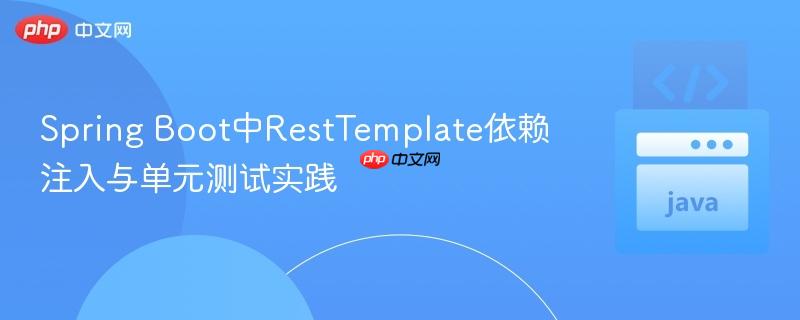
本文旨在解决在spring boot应用中对`resttemplate.exchange()`方法进行单元测试时,因`resttemplate`实例在方法内部创建而导致的mocking失败问题。核心解决方案是通过spring的依赖注入机制,将`resttemplate`作为可注入的组件进行管理,从而使测试能够有效隔离和mock外部依赖,确保代码的可测试性和单元测试的成功执行。
在开发Spring Boot应用程序时,我们经常需要与外部RESTful服务进行交互,RestTemplate是Spring框架提供的一个强大工具。然而,当我们需要对包含RestTemplate调用的业务逻辑进行单元测试时,如果RestTemplate实例是在被测试方法内部直接创建的,那么传统的Mocking技术将无法生效,导致测试失败,甚至可能抛出NoClassDefFoundError等异常。本文将详细阐述如何通过依赖注入(Dependency Injection, DI)模式解决这一问题,并提供清晰的代码示例。
当RestTemplate对象在业务逻辑方法内部(例如UserHelper类的getUserResponse方法)被实例化时,如RestTemplate restTemplate = new RestTemplate();,这个restTemplate实例是方法局部变量,外部无法对其进行控制或替换。在单元测试中,即使我们使用@Mock注解声明了一个RestTemplate的Mock对象,并尝试使用when().thenReturn()进行行为定义,这个Mock对象也无法替换掉方法内部创建的真实RestTemplate实例。因此,当被测试方法执行时,它仍然会尝试调用真实的RestTemplate,而不是我们期望的Mock行为。
解决这一问题的核心在于遵循“依赖倒置原则”和利用Spring的依赖注入机制。我们将RestTemplate从业务逻辑方法内部的局部变量,转变为通过构造器或Setter方法注入的外部依赖。
首先,需要确保你的业务逻辑类(例如UserHelper)是一个Spring管理的组件。这可以通过在类上添加@Service、@Component、@Repository或@Controller等注解来实现。这使得Spring容器能够扫描并管理这个类的实例。
import org.springframework.stereotype.Service;
import org.springframework.web.client.RestTemplate;
@Service
public class UserHelper {
private final RestTemplate restTemplate; // 声明为final,通过构造器注入
// 通过构造器注入RestTemplate
public UserHelper(RestTemplate restTemplate) {
this.restTemplate = restTemplate;
}
public UserResponse getUserResponse(UserPayload userPayload) {
String url = "abc/def";
HttpHeaders headers = new HttpHeaders();
headers.setAccept(Collections.singletonList(MediaType.APPLICATION_JSON));
// ... 其他headers设置
HttpEntity<UserPayload> httpEntity = new HttpEntity<>(userPayload, headers);
// 使用注入的restTemplate实例
ResponseEntity<UserPayload> responseEntity = restTemplate.exchange(url, HttpMethod.POST, httpEntity, UserPayload.class);
// ... 处理响应
return new UserResponse(); // 假设返回UserResponse
}
}关键点:
为了让Spring容器能够提供一个RestTemplate实例进行注入,我们需要将其定义为一个Spring Bean。这通常在一个配置类中完成。
import org.springframework.boot.SpringApplication;
import org.springframework.boot.autoconfigure.SpringBootApplication;
import org.springframework.context.annotation.Bean;
import org.springframework.web.client.RestTemplate;
@SpringBootApplication
public class YourApplicationName {
public static void main(String[] args) {
SpringApplication.run(YourApplicationName.class, args);
}
@Bean
public RestTemplate restTemplate() {
return new RestTemplate();
}
}关键点:
完成上述重构后,我们现在可以轻松地对UserHelper进行单元测试,并通过Mocking来控制RestTemplate的行为。
import org.junit.jupiter.api.BeforeEach;
import org.junit.jupiter.api.Test;
import org.junit.jupiter.api.extension.ExtendWith;
import org.mockito.ArgumentMatchers;
import org.mockito.InjectMocks;
import org.mockito.Mock;
import org.mockito.MockitoAnnotations;
import org.mockito.junit.jupiter.MockitoExtension;
import org.springframework.http.HttpEntity;
import org.springframework.http.HttpMethod;
import org.springframework.http.HttpStatus;
import org.springframework.http.ResponseEntity;
import org.springframework.web.client.RestTemplate;
import static org.mockito.Mockito.when;
import static org.mockito.ArgumentMatchers.any;
import static org.mockito.ArgumentMatchers.eq;
@ExtendWith(MockitoExtension.class) // 使用Mockito JUnit 5扩展
public class UserHelperTest {
@Mock
private RestTemplate restTemplate; // Mock RestTemplate
@InjectMocks
private UserHelper userHelper; // 注入Mock的RestTemplate到UserHelper实例中
// 假设UserPayload和UserResponse是你的数据传输对象
static class UserPayload {}
static class UserResponse {}
@BeforeEach
void setUp() {
// MockitoAnnotations.openMocks(this); // 如果不使用@ExtendWith(MockitoExtension.class),则需要此行
}
@Test
void getUserResponseTest() {
// 准备Mock响应
UserPayload mockUserPayload = new UserPayload();
ResponseEntity<UserPayload> mockResponseEntity = new ResponseEntity<>(mockUserPayload, HttpStatus.OK);
// 定义当restTemplate.exchange被调用时的行为
when(restTemplate.exchange(
ArgumentMatchers.anyString(), // 匹配任何URL字符串
ArgumentMatchers.eq(HttpMethod.POST), // 匹配POST方法
ArgumentMatchers.any(HttpEntity.class), // 匹配任何HttpEntity
ArgumentMatchers.eq(UserPayload.class) // 匹配UserPayload.class
)).thenReturn(mockResponseEntity);
// 调用被测试方法
UserResponse response = userHelper.getUserResponse(mockUserPayload);
// 验证结果 (根据实际业务逻辑进行断言)
// 例如:assertNotNull(response);
// 例如:assertEquals(expectedValue, response.getData());
}
}关键点:
通过上述步骤,我们成功地将RestTemplate从业务逻辑方法内部解耦出来,并通过Spring的依赖注入机制进行管理。这不仅解决了单元测试中Mocking失败的问题,还带来了以下好处:
在实际开发中,始终优先考虑使用依赖注入来管理外部依赖,这将大大简化单元测试的编写和维护,提升代码质量。对于RestTemplate,还可以进一步配置连接池、超时时间、拦截器等,并通过@Bean的方式统一管理,确保整个应用的HTTP客户端行为一致且可控。
以上就是Spring Boot中RestTemplate依赖注入与单元测试实践的详细内容,更多请关注php中文网其它相关文章!

每个人都需要一台速度更快、更稳定的 PC。随着时间的推移,垃圾文件、旧注册表数据和不必要的后台进程会占用资源并降低性能。幸运的是,许多工具可以让 Windows 保持平稳运行。




Copyright 2014-2025 https://www.php.cn/ All Rights Reserved | php.cn | 湘ICP备2023035733号